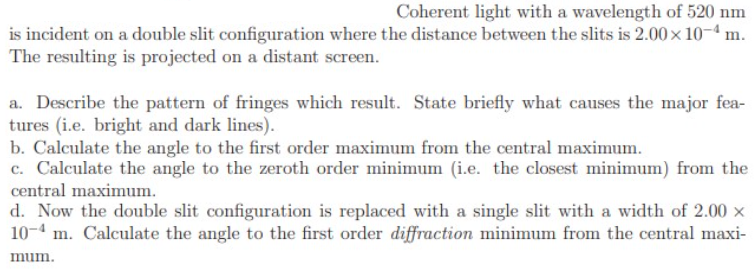Coherent light with a wavelength of 520 nm is incident on a double slit configuration where the distance between the slits is 2.00 x 10-4 m. The resulting is projected on a distant screen. a. Describe the pattern of fringes which result. State briefly what causes the major fea- tures (i.e. bright and dark lines). b. Calculate the angle to the first order maximum from the central maximum. c. Calculate the angle to the zeroth order minimum (i.e. the closest minimum) from the central maximum. d. Now the double slit configuration is replaced with a single slit with a width of 2.00 x 10-4 m. Calculate the angle to the first order diffraction minimum from the central maxi- mum.
Coherent light with a wavelength of 520 nm is incident on a double slit configuration where the distance between the slits is 2.00 x 10-4 m. The resulting is projected on a distant screen. a. Describe the pattern of fringes which result. State briefly what causes the major fea- tures (i.e. bright and dark lines). b. Calculate the angle to the first order maximum from the central maximum. c. Calculate the angle to the zeroth order minimum (i.e. the closest minimum) from the central maximum. d. Now the double slit configuration is replaced with a single slit with a width of 2.00 x 10-4 m. Calculate the angle to the first order diffraction minimum from the central maxi- mum.
University Physics Volume 3
17th Edition
ISBN:9781938168185
Author:William Moebs, Jeff Sanny
Publisher:William Moebs, Jeff Sanny
Chapter4: Diffraction
Section: Chapter Questions
Problem 34P: Two slits of width 2 m, each in an opaque material, are separated by a center-to-center distance of...
Related questions
Question

Transcribed Image Text:Coherent light with a wavelength of 520 nm
is incident on a double slit configuration where the distance between the slits is 2.00 x 10-4 m.
The resulting is projected on a distant screen.
a. Describe the pattern of fringes which result. State briefly what causes the major fea-
tures (i.e. bright and dark lines).
b. Calculate the angle to the first order maximum from the central maximum.
c. Calculate the angle to the zeroth order minimum (i.e. the closest minimum) from the
central maximum.
d. Now the double slit configuration is replaced with a single slit with a width of 2.00 x
10-4 m. Calculate the angle to the first order diffraction minimum from the central maxi-
mum.
Expert Solution
This question has been solved!
Explore an expertly crafted, step-by-step solution for a thorough understanding of key concepts.
This is a popular solution!
Trending now
This is a popular solution!
Step by step
Solved in 3 steps

Recommended textbooks for you

University Physics Volume 3
Physics
ISBN:
9781938168185
Author:
William Moebs, Jeff Sanny
Publisher:
OpenStax

Physics for Scientists and Engineers, Technology …
Physics
ISBN:
9781305116399
Author:
Raymond A. Serway, John W. Jewett
Publisher:
Cengage Learning

College Physics
Physics
ISBN:
9781285737027
Author:
Raymond A. Serway, Chris Vuille
Publisher:
Cengage Learning

University Physics Volume 3
Physics
ISBN:
9781938168185
Author:
William Moebs, Jeff Sanny
Publisher:
OpenStax

Physics for Scientists and Engineers, Technology …
Physics
ISBN:
9781305116399
Author:
Raymond A. Serway, John W. Jewett
Publisher:
Cengage Learning

College Physics
Physics
ISBN:
9781285737027
Author:
Raymond A. Serway, Chris Vuille
Publisher:
Cengage Learning

College Physics
Physics
ISBN:
9781305952300
Author:
Raymond A. Serway, Chris Vuille
Publisher:
Cengage Learning

Physics for Scientists and Engineers: Foundations…
Physics
ISBN:
9781133939146
Author:
Katz, Debora M.
Publisher:
Cengage Learning

Physics for Scientists and Engineers
Physics
ISBN:
9781337553278
Author:
Raymond A. Serway, John W. Jewett
Publisher:
Cengage Learning